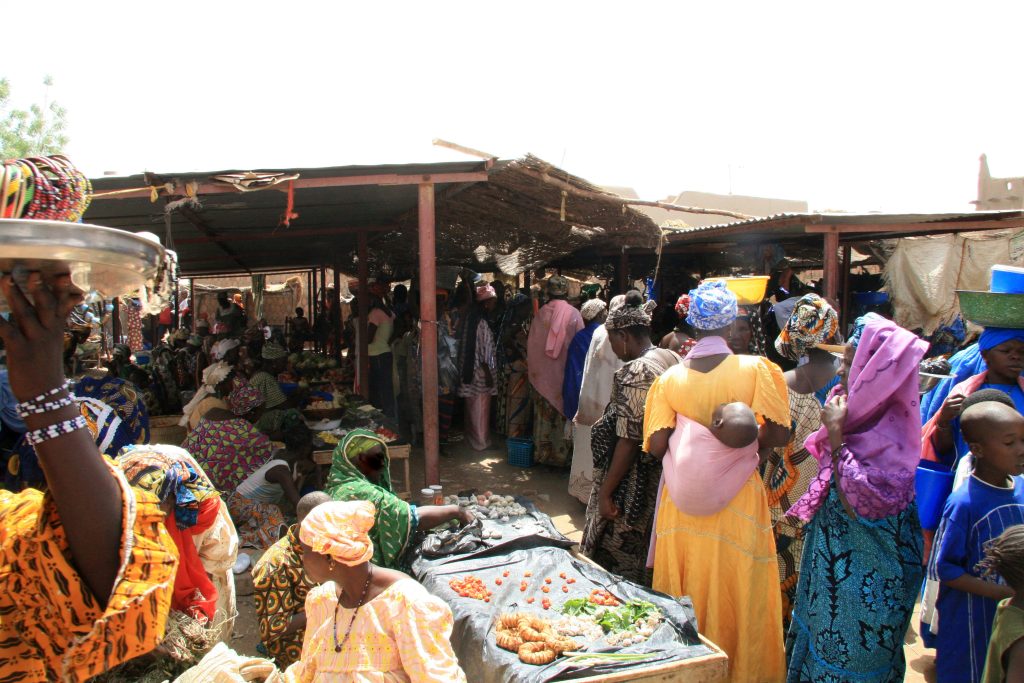Like other regions of the world, economic activity in the WAEMU zone in 2020 was negatively impacted by the COVID-19 pandemic. As of January 26, 2021, the Union reported 85,791 confirmed cases, including 1,506 deaths, and 10,723 active cases. Even though this toll seems lower compared to that of many countries and economic regions, the last quarter of 2020 saw a spike in COVID-19 cases in the WAEMU zone. Thus, the number of active cases rose from 5,038 at the beginning of October to 2,861 at the end of November 2020 before rising to 6,862 cases at the end of December 2020. If this trend were to continue, it could jeopardize the recovery of economic activity expected in 2021.
According to the WAEMU Commission’s multilateral surveillance data published at the end of December 2020, the WAEMU zone’s growth rate would slow by 5.1 points compared to 2019 to 0.7 percent in 2020. In contrast, the global economy and sub-Saharan Africa are expected to be in recession in 2020 with GDP contractions of 3.5% and 2.6% respectively. The recovery in activity expected in 2021 should bring growth in the WAEMU zone to 5.3%, while the world economy and sub-Saharan Africa will grow by 5.5% and 3.2% respectively.
The downturn in activity in 2020 has resulted in lower budgetary revenues for Member States. The drop in revenues combined with the increase in public spending induced by the COVID-19 pandemic led to the deterioration of the main budget balances in all the countries of the Union in 2020. Thus, none of the countries in the region met the convergence criterion for budget deficits, which is set at 3.0%. Overall, the ratio of outstanding public debt to nominal GDP jumped by 5.2 points compared with 2019 to 49.3%, in line with the increase in the budget deficit. If left unchecked, this trend could increase the debt vulnerabilities of WAEMU countries.
Although growth in the WAEMU zone is expected to be dynamic over the period 2021-2023 with an average GDP growth rate of 6.9%, fiscal consolidation is not expected to take place in the zone before 2024.
This note analyzing the economic situation of the WAEMU zone in 2020 and the medium-term outlook is structured around the following points:
- WAEMU zone economy in 2020
- Medium-term economic outlook
- Impact of COVID-19 on the indebtedness of WAEMU Member States
1. WAEMU zone economy in 2020 – a resilient economic union
Despite the slowdown in economic growth in the WAEMU zone in 2020, this zone appears to have been more resilient to the COVID-19 pandemic than other regions of the world that experienced a recession. The factors explaining this resilience are inherent in the specificities of the economies of Member States, the response measures adopted by the authorities of these States as soon as the first cases of COVID-19 were confirmed and the support provided by regional institutions and development partners.
- The COVID-19 pandemic led to a slowdown in economic activity and an increase in budget deficit
As soon as the first cases of COVID-19 were confirmed in early March, WAEMU Member States adopted measures to limit the spread of the pandemic. These measures consisted in raising awareness on prevention measures, closing public places, instituting curfews and isolating large urban centers, which are the main foci of the disease. These measures have certainly helped to contain the pandemic. However, they have had a negative impact on the various economic sectors. The quarterly GDP growth rate in the WAEMU zone, at an annual rate, fell from 4.3% in the fourth quarter of 2019 to 3.2% in the first quarter of 2020 before falling into negative territory at -2.0% in the second quarter of the year. However, activity recovered in the WAEMU zone in the third quarter of 2020 by 0.6% in connection with the gradual lifting of restrictions imposed by States to fight COVID-19. Overall, the Union’s growth rate is expected to be 0.7% in 2020 after 5.9% in 2019, a slowdown of 5.2 points. Inflation rose in 2020 in all WAEMU Member States. The inflation rate was above the norm in two Member States: Benin (+3.3%) and Niger (+3.1%). Overall, the inflation rate was 2.3% in 2020, compared with -0.7% a year earlier. The disruption in distribution channels caused by the COVID-19 pandemic contributed to price increase in the WAEMU zone.
The slowdown in activity has resulted in a 2.76% drop in budgetary revenues for the Union States. At the same time, public spending increased by 20.83%, leading to a worsening of the budget deficit. The Union’s overall budget deficit with grants is expected to rise to 5.9% of GDP in 2020 after 2.5% in 2019.
- However, the trade balance has improved
In terms of foreign trade, exports of goods from the Union stood at XOF 16,699.3 billion, down by XOF 778.8 billion compared with 2019. This decline is explained by the fall in prices of the primary products exported by the Union’s member countries, notably cocoa, coffee and cotton. On the other hand, gold prices increased over the period due to the yellow metal’s status as a safe haven. As for imports of goods from the union, they fell by XOF 689.1 billion compared to 2019 to stand at XOF 20,236.2 billion in 2020. In return, the Union’s trade balance improved by 89.6 billion attributable to a larger decline in imports compared to exports.
2. Economic outlook for the WAEMU zone
The economic outlook for WAEMU Member States remains favorable. The zone should benefit from the global economic recovery and from initiatives undertaken at the Union level both in the fight against the COVID-19 pandemic and in terms of economic recovery. As a reminder, WAEMU Member States have drawn up response and economic recovery plans at a total cost of about XOF 5,776.5 billion. A significant proportion of the budget has gone to health sector expenditure (XOF 1,142.5 billion) and social assistance (XOF 1,047.5 billion). More than XOF 3,586.4 billion of this budget is devoted to economic recovery as a support to the various economic sectors affected by the pandemic.
- WAEMU zone should benefit from the global economic recovery
According to the International Monetary Fund’s (IMF) January 2021 World Economic Outlook, the world economy is expected to grow by 5.2% in 2021 after a 3.5% decline in 2020. WAEMU zone’s main partners economies are expected to recover, notably France (+6.0%) and China (+8.0%). Growth in Sub-Saharan Africa is forecast at 3.1%. The growth rate for the WAEMU zone is expected to be just over 5.0%.
The recovery of the world economy should lead to an increase in world demand, hence the increase in prices of primary commodities exported by WAEMU Member States, as per 2021 projection. According to World Bank projections, the price of cocoa on the international market is expected to rise from US$2.40 per kilo in 2020 to US$2.44 per kilo in 2021, before reaching US$2.48 per kilo in 2022. This upward trend should continue in the medium term. Robusta coffee prices are also expected to rise over the period, from US$1.50 per kilo in 2020 to US$1.54 per kilo in 2021. Cotton prices are expected to reach US$1.60 per kilo in 2021, up US$0.05 from 2020. Gold prices, a safe haven in this period of crisis, are expected to decline in the medium term due to the recovery of the global economy. However, they would be higher than their level before the COVID-19 pandemic.
- The internal outlook for the WAEMU zone is encouraging
The economies of the WAEMU zone should benefit from a favorable regional environment due to the low incidence of the COVID-19 pandemic in the zone, the prospect of access to COVID-19 vaccines through the COVAX mechanism, and the support public authorities, regional and international organizations gave in response to COVID-19 as well as the support measures for the economy.
Despite the rising number of COVID-19 cases, its relatively low incidence in the WAEMU zone has swayed the decision of Members States in their majority not to impose restrictions as was the case in the first half of 2020. In addition, Members States are in line to benefit from access to COVID-19 vaccines through the activation of the COVAX mechanism. These two factors should limit the impact of COVID-19 on the zone’s economy and facilitate the implementation of economic support measures adopted by all Member States.

Source: WAEMU Commission, Multilateral Surveillance Report December 2020
3. Impact of COVID-19 on the indebtedness of WAEMU Member States
The COVID-19 pandemic has resulted in an increase in the budget deficit in WAEMU Member States due to the low mobilization of budgetary revenues and an increase in public expenditure that it has caused. This situation has resulted in an increase in the debt ratio. This trend is expected to continue in the medium term in relation to the financing of the various economic sectors affected by the pandemic. However, the control of the budget deficit in the medium term and the prudent debt policy adopted by the States of the Union should help in preserving debt sustainability.

Source: WAEMU Commission, Multilateral Surveillance Report December 2020
- The pandemic has contributed to an increase in the debt ratio
The Union’s overall debt ratio is expected to reach 49.3% in 2020, up 5.2 percentage points from 2019, due to the deterioration of the budget deficit and the slowdown in growth. The Union’s debt ratio has increased remarkably over the last five (5) years as a result of the implementation of major investment projects included in national development plans adopted by WAEMU Member States. Thus, the outstanding debt of all the States of the Union as a percentage of the Union’s nominal GDP rose from 33.5% in 2015 to 44.1% in 2019, i.e. an increase of 10.6% in five years, driven by external debt. After a significant decline at the beginning of the last decade under the Heavily Indebted Poor Country (HIPC) program and the Multilateral Debt Cancellation Initiative (MDCI), the Union’s external debt has increased significantly over the last ten years. According to the WAEMU Commission’s multilateral surveillance data, the external debt stock rose from XOF 8,845.8 billion in 2012 to XOF 25,823.7 billion in 2019 before reaching XOF 29,263.8 billion in 2020; an increase of XOF 20,418.0 billion in 10 years. The exceptional increase between 2019 and 2020 is explained by the financial support provided by the Union’s main multilateral partners, notably the IMF, the World Bank, the ADB and the G20. As a proportion of nominal GDP, the external debt stock rose from 16.5% in 2012 to 21.1% in 2015 before reaching 29.4% in 2019. The external debt stock would represent 32.5% of the Union’s nominal GDP in 2020.
- A trend that should continue in the short term
The Union’s debt ratio would be 50.1% in 2021, up 0.8 percentage points from 2020, before falling back to 49.3% in 2022 as in 2020. The Union’s debt ratio should begin to fall from 2023 onwards, in line with budget deficit control and the dynamics of economic activity expected over the period. The budget deficit is expected to improve over the period 2021-2023 while remaining above the Union’s standard of 3.0 percent before settling at 2.7 percent of GDP in 2024. The ratio of external debt to GDP is expected to decline from 2021 onwards, reflecting a smaller increase in external debt compared to wealth creation in the Union.
- Nevertheless, the debt sustainability of Member States would be preserved
The States of the Union have a prudent debt policy operationalized by Medium-Term Debt Management Strategies (MTDS) that favor the use of concessional resources as the main source of coverage of their financing needs. This strategy provides access to long and inexpensive resources. This reduces the risk of refinancing the debt of these countries. Given the limitations of these resources, the regional financial market is an important source of resources to supplement external debt.
In the short term, the States of the Union benefited from favorable financing conditions to finance the expenses incurred by the COVID-19 pandemic. Internally, the accommodating monetary policy adopted by the Central Bank of West African States (BCEAO) contributed to the easing of exit rates for securities issued by the States on Government Securities Market (GSM). This situation has enabled governments to raise debt on the GSM on advantageous terms. At the international level, governments have benefited from the support of their main multilateral partners (IMF, World Bank) and the Debt Service Suspension Initiative (DSSI) supported by the G20. This initiative aims to help beneficiary countries devote their resources to the fight against the pandemic. The end of the suspension period, which was initially scheduled for December 31, 2020, has been extended to June 2021. With the exception of Benin, all WAEMU countries benefit from the DSSI. As of January 12, 2021, the potential savings for these countries are estimated at US$525.4 million. Thus, DSSI has helped to reduce vulnerabilities linked to the States’ external debt as they defer payment of external debt service.
The favorable economic outlook in the medium term should enable the States of the Union to improve the mobilization of budget revenues. This should enable them to guarantee the fiscal space needed to service their debt without major constraints on public finances and to meet all their payment obligations. Thus, debt control and a favorable economic outlook would enable the States of the Union to preserve their debt sustainability.
The COVID-19 pandemic resulted in a slowdown in economic activity in the WAEMU zone in 2020 and an increase in the debt ratio linked to increased budget deficit. Economic recovery in the Union is expected from 2021 onwards, thanks to the recovery of the global economy and the implementation of recovery plans adopted by Member States. On the other hand, the effects of the current health crisis on government debt should continue in the medium term as per budget deficit levels. The debt ratio is expected to fall from 2022 onwards in line with the gradual reduction in budget deficit, reaching its pre-crisis level in 2024. Fiscal consolidation would not take place before 2024. Member States benefited from favorable financing conditions in 2020 and the favorable economic outlook in the medium term should facilitate debt sustainability, provided prudent debt policy is maintained.
Externally, governments should continue to give preference to concessional financing, preferably denominated in euros, in order to reduce their exposure to exchange rate risk. Internally, governments should continue their efforts to develop the Government Securities Market and optimize their debt management in conjunction with UMOA-Titres, in particular by
- using domestic loans with longer maturities (5 years and more);
- reinforcing actions and measures to optimize government intervention on the market;
- carrying out active debt management operations (repurchase and/or exchange of securities)
- aligning State practices with market standards.
All the above actions should help reduce the refinancing risk, which remains the main vulnerability inherent in domestic debt.












